Casio HT-6000: owned from June 2003 to present, bought for $94
Although it looks like a boring home keyboard (complete with cheap all-plastic construction, auto-accompanyment, and built-in speakers), it's actually a fairly sophisticated synthesizer with some very unusual features. Like the other models in the HT-series, it's 8-voice polyphonic and has digital waveforms passing through analog filters. But it's much more complex than that..
For the upper tones, there are 4 oscillators per voice, each sharing the same waveform, envelope, and pitch modulation, but with the possibility of different tunings and velocity sensitivities (with 10 different velocity curves that enable neat things like crossfades). There are 64 waveforms, broken down into two groups. The first just uses straight waveforms with nothing special going on. The second group containes a lot of the same waves as the first group, but with some extra stuff thrown in. The first 16 waves of the second group have noise included. There are two types of noise, white noise (actually a poor digital approximation of white noise), and metallic (which sounds kind of irritating). Noise gets its own independent envelope. The second group of 16 waves uses ring modulation between the third and fourth oscillators. Since all of the oscillators have the same pitch modulation, it's not possible to get neat ring modulator sweeps like in the ESQ-M or VZ-10M or other ring modulator-equipped synthesizers, but it's nice to add a different sound to the waves. All of the waveforms are gritty single-cycle waveforms consisting of only 16 steps each (see the MT-68 page for more info there). The first few waves are triangle, saw, square, and several varieties of pulse waves. The triangle wave sounds very much like the one in the NES, which is good news to me. Most of the other waves have a samey sort of quality, sounding somewhat like pulse or organ waveforms. Some of the waves have an interesting crossfade effect that can be controlled to some extent by the envelopes. There's a single delayed LFO that only affects the pitch. The available LFO waveforms are triangle, rising saw, falling saw, square, and random (which is actually a cyclic wave, as in the ESQ-M). The LFO really doesn't go very fast and it can't modulate the pitch by more than about 2 semitones. The VCF has an ADSR envelope, and parameters for cutoff, resonance (only 0 to 7, and resonance doesn't get very high), envelope amount, velocity sensitivity (I haven't figured this out yet, it seems to have several different velocity curves throughout its range), and key follow amount. Then there's the amplitude envelope, followed by parameters for attack curve, decay curve, and another key follow parameter. I don't understand what these are for either (no manual). The envelopes are great for fast attacks and decays but the maximum times aren't very long at all. Noise gets an ADSR envelope if it's used in the patch, and then there are parameters for chorus (off or 3 settings, very nice sounding) and transposition. There's no mono mode or portamento.
Lower tones are mostly the same only with two oscillators per voice and no ring modulation waveforms. They use the same chorus setting as the selected upper tone patch. They are used when keyboard split is turned on for bitimbral stuff or for auto-accompanyment. Also when auto-accompanyment is used there are 4 bass and 6 obbligato sounds available. These aren't editable, though. Through midi, the upper tone, lower tone, bass, and obbligato sounds can all be played by different midi channels, with no restrictions on keyboard range. The lower tone, bass, and obbligato sounds seem to use some weird method of sharing voices for greater polyphony when using accompanyment.
There are 18 drum sounds (plus accent) that can be used in custom rhythm patterns. All the drum sounds from the SK-5 are present, as well as a bunch of others, including a really grainy orchstra hit. Drum programming depends on the quantization and time signature of the pattern that's being overwritten. For each rhythm it's also possible to write an auto-accompanyment pattern consisting of a bassline and a selection of chord inversions. This is pretty interesting as I don't know of any other similar keyboards that allow custom accompanyment patterns.
Patches are edited using two knobs: one selects the parameter by number (a list of parameters is silk-screened on the top of the panel) and the other controls the value of the parameter. "Line Edit" functions (detune, amplitude, and velocity sensitivity for each oscillator) are edited using a set of 8 little increment/decrement buttons under the display- two for each oscillator. There are 20 preset and 20 user patches for upper tone sounds, 10 patches each for lower tone sounds, and 20 preset/10 user rhythm and accompanyment patterns. There's no backup battery so all the patches are lost when it's unplugged and without batteries. There's a slot for ROM/RAM cards but I don't have one and I've never seen one for sale. Upper tone, Lower tone, and bass (or something like that) respond to consecutive midi channels, and midi clock can be set to internal or external.
Inside there is a surprisingly large amount of hardware. The digital board has a NEC 78C10 CPU running at 15MHz, and an 80C49HC running at 10 MHz for midi. There are also 3 MSM6294 chips, and NEC D65006 and D65012G chips, which seem to be custom designs (one probably responsible for drum sounds). On the analog board there are 4 NEC D935G chips for main sound generation. They seem closely related to the D931C chip found in the MT-68 and similar models (more info on the MT-68 page). The filters are NJM2090 chips, which seem like custom designs. There are a lot of trimmers but none of them are labeled so I can't boost the resonance without messing up the calibration of everything. There's an MSM6200GS chip attatched to the keyboard, presumably used to calculate the key velocities and things like that (there are two rubber dome switches under each key). The chorus effect is from an MN3207 BBD, with an MN3102 driver.
Overall the sound is very nice, it has a uniquely clear and crisp sort of quality that works best for ethereal digital ambient sounds. Unfortunately the envelopes are too fast to make really good slow pad sounds, but percussive type sounds are excellent. There isn't much bass and the notes don't go very low so it's not great in depatment either. But it definately has some great sounds that I would have trouble replicating on any other synth I've used.
pictures: Mine is missing the original knobs, I replaced them with ugly radio shack ones.
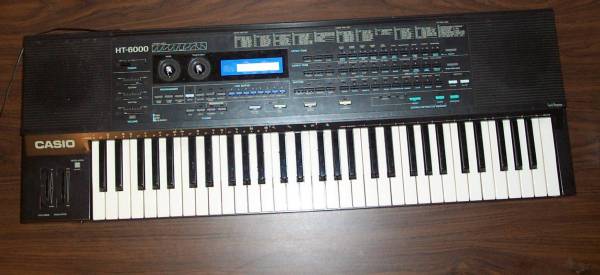
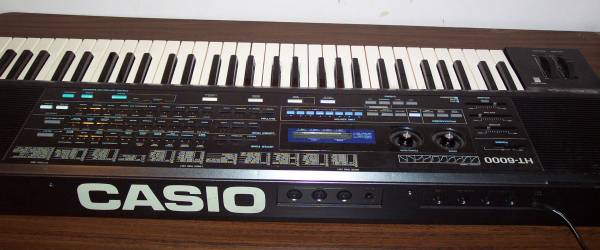
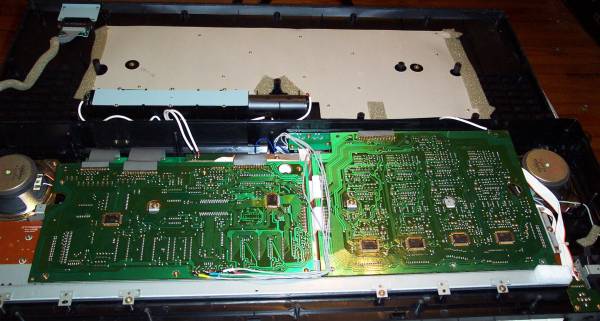
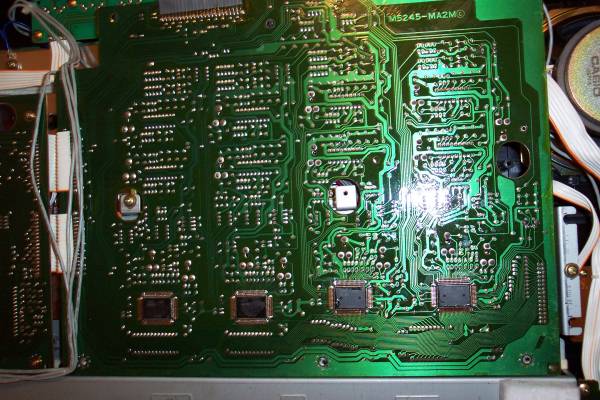
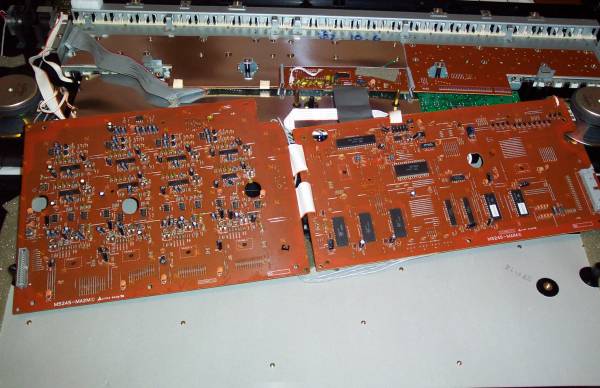
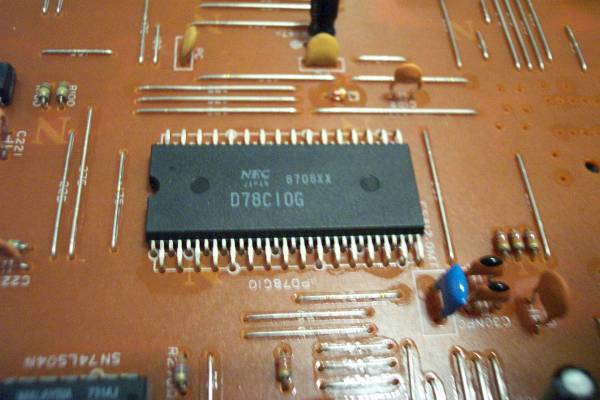
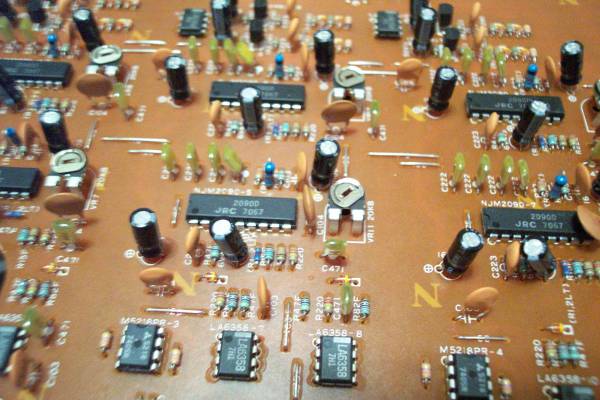
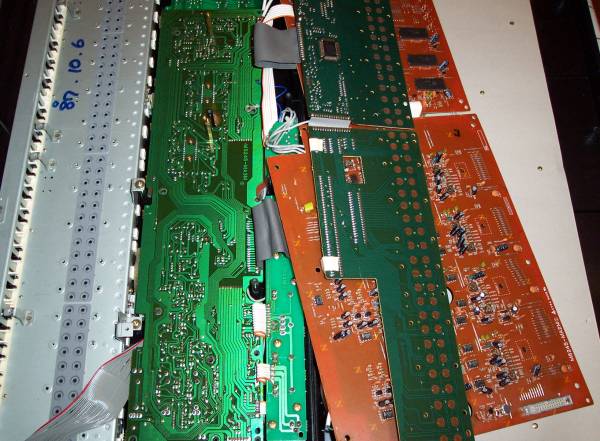
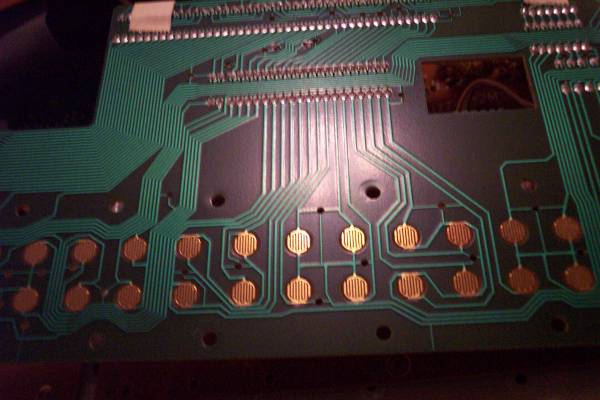
sounds:
HT-6000-1- I changed the demo to save space, this one actually uses the accompanyment instead of external sequencing, so it makes more sense to put it here anyway. The old one is here.
links:
Here's the page that inspired me to get an HT-6000: CASIO SD Synthesis II: HT-6000
back to synth index